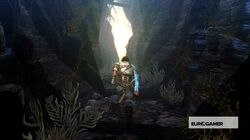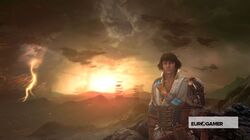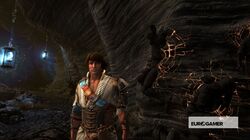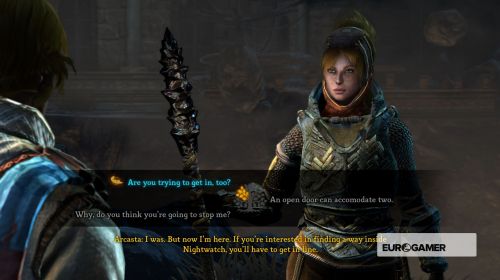- Joined
- Jan 28, 2011
- Messages
- 100,044















Tags: Chris Parker; Feargus Urquhart; Microsoft; Obsidian Entertainment; Stormlands
Stormlands, also known as Project North Carolina, was a Microsft-published Obsidian RPG that was meant to be a launch title for the XBox One console. Its cancellation in early 2012 resulted in mass layoffs and nearly killed the company, setting them on the path to Kickstarter and their revival as the "nu-Obsidian" we know and love today. The name Stormlands was first revealed at Kotaku back in 2015, but very little was known about the game, other than that it later (kinda sorta) turned into what would become Tyranny. Today, in what is surely the most interesting reveal in the ongoing Obsidian media campaign, Eurogamer have published a special weekend feature about Stormlands, revealing what this unintentionally pivotal title was about for the first time. The article includes several screenshots from the game's pitch demo, which I'll include along with an excerpt:






The demo, running on the Dungeon Siege 3 engine, is visually impressive, even now, several years and a new console later. There's a bruised peach tone to the otherworldly sky, which rumbles and crackles with storms while a haunting kind of Arabian music moans in the background. It reminds me immediately of Assassin's Creed or a Prince of Persia, with the main character, a man, wrapped in similar-styled clothes, a cloak slung over one shoulder. There's a brooding atmosphere, helped no end by the bodies a storm has entombed in the rocky mountainside around us.
We eventually come across a female character who was to be one of your companions. She takes her facial armour off before talking to us, which is a nice touch - it bugs me in other RPGs when characters waffle away like noisy, bobbing helmets. A classic dialogue screen of choices appears and the characters interact, fully voiced. On the horizon is a kind of castle we're aiming for and from which, by the demo's culmination, a huge enemy erupts. "That was the pitch that got us the project," says Urquhart as it ends.
He loads a Stormlands development milestone video on his screen afterwards, which revolves around combat and is narrated by one of the Stormlands team. This appears in grey-box form so there are no textures only a smooth grey skin coating everything - characters, enemies and terrain. In this video I see the character rolling to evade attacks, as in The Witcher, and teleporting short distances, as Ciri does in The Witcher 3. I also see a variety of acrobatic attacks used against a variety of enemies, from beast men to wraiths. Crucially I see companion moves too, special attacks you can trigger allies to perform - it would always be you and one other on a level. These companions and these special partner moves were to be a fundamental cornerstone of the Stormlands experience.
Clearly a lot of work had been done. What, then, went wrong? There was a disconnect, a juxtaposition between a dreaming Microsoft on one hand and an Obsidian who had to realise the ideas on the other. One moment Obsidian was talking to a Microsoft executive producer about doing co-op, the next minute a new executive producer was pitching million-man raids. "We look at something like that and it's like, 'Holy Jesus!'" says Urquhart.
But it's important to point out Obsidian never took the million-man raid idea literally, and never believed Microsoft, as ambitious as it was, meant it that way. "This happens with everything," he says. "We do this when we're talking to our people, we give them crazy ideas. The goal was to inspire us to come up with not that, but inspire us to think about how to incorporate all of these elements." It's like the story of the Sony boss running downstairs to the inventors' lair with a pack of playing cards and declaring, "I want a tape player I can stick headphones into that's this big!" and in doing so triggering the creation of the iconic Walkman.
Nevertheless the demands from Microsoft to reinvent the wheel were high. Kotaku writer Jason Schreier talks about Kinect-powered verbal haggling in Stormlands, in his new book Blood, Sweat and Pixels, which I heartily recommend. Chris Parker and Feargus Urquhart don't recall that exact feature when I talk to them but concede there were so many ideas it may well have been one. Ideas piled upon ideas and all the time the immovable deadline to be ready for Xbox One launch loomed closer.
Microsoft's answer? Throw more resources at it. "At some point Microsoft was saying 'maybe this needs to be an even bigger game'," Urquhart says. "'Maybe we just need to add a bunch more people onto it - maybe we don't have enough people to prototype all these crazy ideas we have.' Well no, actually that sounds terrifying, that sounds like a really bad idea for us to do."
"Sometimes adding people to something doesn't mean it's going to get done any faster," adds Chris Parker. "It's actually just going to be more complicated, more people running down the wrong path."
"I just wish I had flown out to Seattle and got a meeting with Don Mattrick and everybody else," says Urquhart, "and said, 'OK we all agree it would be good to have an RPG at or very close to the launch of Xbox One. We can make RPGs, it's been shown. These are the challenges we have on the table:
"Unreal 4 doesn't exist for the Xbox One yet. We can use Unreal 3 but Unreal's transitioning so that's not good, so we're using our own engine and it's doing great in certain ways but we still have to build it up in other ways. The second challenge is we've not done a lot of multiplayer stuff before. The next challenge is this is a launch title so that date, it's not a 'well if it ships here you're late but that's fine'. We're all doing this, and you guys are on board doing this, because you want it to be a launch title. How do we now make a game that is realistic within all those challenges?
"And I didn't do that," he says, "and that probably contributed to the game getting cancelled."
This ride isn't over yet. At the end of the article, the author lists Obsidian's current projects - Tyranny DLC, Pillars of Eternity II, Pathfinder Adventures, a new project that's just starting (ooh), and a "considerable something else". Which of course we know is a reference to Tim Cain and Leonard Boyarsky's mysterious secret project. Apparently there'll be more information about that next week, although I'd caution against expecting a full-blown reveal.
Stormlands, also known as Project North Carolina, was a Microsft-published Obsidian RPG that was meant to be a launch title for the XBox One console. Its cancellation in early 2012 resulted in mass layoffs and nearly killed the company, setting them on the path to Kickstarter and their revival as the "nu-Obsidian" we know and love today. The name Stormlands was first revealed at Kotaku back in 2015, but very little was known about the game, other than that it later (kinda sorta) turned into what would become Tyranny. Today, in what is surely the most interesting reveal in the ongoing Obsidian media campaign, Eurogamer have published a special weekend feature about Stormlands, revealing what this unintentionally pivotal title was about for the first time. The article includes several screenshots from the game's pitch demo, which I'll include along with an excerpt:






The demo, running on the Dungeon Siege 3 engine, is visually impressive, even now, several years and a new console later. There's a bruised peach tone to the otherworldly sky, which rumbles and crackles with storms while a haunting kind of Arabian music moans in the background. It reminds me immediately of Assassin's Creed or a Prince of Persia, with the main character, a man, wrapped in similar-styled clothes, a cloak slung over one shoulder. There's a brooding atmosphere, helped no end by the bodies a storm has entombed in the rocky mountainside around us.
We eventually come across a female character who was to be one of your companions. She takes her facial armour off before talking to us, which is a nice touch - it bugs me in other RPGs when characters waffle away like noisy, bobbing helmets. A classic dialogue screen of choices appears and the characters interact, fully voiced. On the horizon is a kind of castle we're aiming for and from which, by the demo's culmination, a huge enemy erupts. "That was the pitch that got us the project," says Urquhart as it ends.
He loads a Stormlands development milestone video on his screen afterwards, which revolves around combat and is narrated by one of the Stormlands team. This appears in grey-box form so there are no textures only a smooth grey skin coating everything - characters, enemies and terrain. In this video I see the character rolling to evade attacks, as in The Witcher, and teleporting short distances, as Ciri does in The Witcher 3. I also see a variety of acrobatic attacks used against a variety of enemies, from beast men to wraiths. Crucially I see companion moves too, special attacks you can trigger allies to perform - it would always be you and one other on a level. These companions and these special partner moves were to be a fundamental cornerstone of the Stormlands experience.
Clearly a lot of work had been done. What, then, went wrong? There was a disconnect, a juxtaposition between a dreaming Microsoft on one hand and an Obsidian who had to realise the ideas on the other. One moment Obsidian was talking to a Microsoft executive producer about doing co-op, the next minute a new executive producer was pitching million-man raids. "We look at something like that and it's like, 'Holy Jesus!'" says Urquhart.
But it's important to point out Obsidian never took the million-man raid idea literally, and never believed Microsoft, as ambitious as it was, meant it that way. "This happens with everything," he says. "We do this when we're talking to our people, we give them crazy ideas. The goal was to inspire us to come up with not that, but inspire us to think about how to incorporate all of these elements." It's like the story of the Sony boss running downstairs to the inventors' lair with a pack of playing cards and declaring, "I want a tape player I can stick headphones into that's this big!" and in doing so triggering the creation of the iconic Walkman.
Nevertheless the demands from Microsoft to reinvent the wheel were high. Kotaku writer Jason Schreier talks about Kinect-powered verbal haggling in Stormlands, in his new book Blood, Sweat and Pixels, which I heartily recommend. Chris Parker and Feargus Urquhart don't recall that exact feature when I talk to them but concede there were so many ideas it may well have been one. Ideas piled upon ideas and all the time the immovable deadline to be ready for Xbox One launch loomed closer.
Microsoft's answer? Throw more resources at it. "At some point Microsoft was saying 'maybe this needs to be an even bigger game'," Urquhart says. "'Maybe we just need to add a bunch more people onto it - maybe we don't have enough people to prototype all these crazy ideas we have.' Well no, actually that sounds terrifying, that sounds like a really bad idea for us to do."
"Sometimes adding people to something doesn't mean it's going to get done any faster," adds Chris Parker. "It's actually just going to be more complicated, more people running down the wrong path."
"I just wish I had flown out to Seattle and got a meeting with Don Mattrick and everybody else," says Urquhart, "and said, 'OK we all agree it would be good to have an RPG at or very close to the launch of Xbox One. We can make RPGs, it's been shown. These are the challenges we have on the table:
"Unreal 4 doesn't exist for the Xbox One yet. We can use Unreal 3 but Unreal's transitioning so that's not good, so we're using our own engine and it's doing great in certain ways but we still have to build it up in other ways. The second challenge is we've not done a lot of multiplayer stuff before. The next challenge is this is a launch title so that date, it's not a 'well if it ships here you're late but that's fine'. We're all doing this, and you guys are on board doing this, because you want it to be a launch title. How do we now make a game that is realistic within all those challenges?
"And I didn't do that," he says, "and that probably contributed to the game getting cancelled."


























